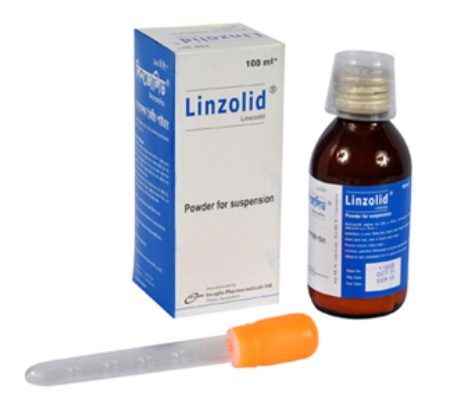
Type:100ml bot
Generic Name:Linezolid
Manufacturer:Incepta Pharmaceuticals Ltd.
Price:৳280.00
Community-acquired pneumonia, Skin and skin structure infections, Nosocomial pneumonia
May be taken with or without food.
Oral Uncomplicated skin and skin structure infections Adult: 400 mg 12 hrly for 10-14 days. Vancomycin-resistant Enterococcus faecium Adult: 600 mg 12 hrly for 14-28 days. Methicillin-resistant <I>Staphylococcus aureus<D> infections Adult: 600 mg bid for 7-21 days. Community-acquired pneumonia; Nosocomial pneumonia; Complicated skin and skin structure infections Adult: 600 mg 12 hrly for 10-14 days. Elderly: No dosage adjustment needed. Hepatic impairment: Mild to moderate: No dosage adjustment needed.
Oral For Pediatric Patients Pneumonia, complicated skin infections, vancomycin resistant enterococci: Birth–11 y: 30 mg/kg/day q8h >11 y: 1,200 mg/day q12h Uncomplicated skin infections: Birth–5 y: 30 mg/kg/day q8h 5–11 y: 20 mg/kg/day q12h >11–18 y: 1,200 mg/day q12h
Renal impairment: No dosage adjustment needed.
Linzolid formulations are contraindicated for use in patients who have known hypersensitivity to Linzolid or any of the other product components. Linzolid should not be used in patients taking any medicinal product which inhibits monoamine oxidases A or B (e.g. phenelzine, isocarboxazid) or within two weeks of taking any such medicinal product. Linzolid should not be administered to patients with uncontrolled hypertension, pheochromocytoma, thyrotoxicosis, carcinoid syndrome and/or patients taking directly and indirectly acting sympathomimetic agents (e.g. pseudoephedrine), vasopressive agents (e.g. epinephrine, norepinephrine), dopaminergic agents (e.g. dopamine, dobutamine), serotonin re-uptake inhibitors, tricyclic antidepressants, serotonin 5-HT1 receptor agonists (triptans), meperidine or buspirone.
Linezolid is a bacteriostatic oxazolidinone which acts by inhibiting ribosomal protein synthesis. It is active against gm+ve bacteria including vancomycin-resistant enterococci and MRSA. It has limited in vitro activity against gm-ve bacteria.
Preexisting myelosuppression, renal impairment (CrCl < 30ml/min), uncontrolled hypertension, phaeochromocytoma, carcinoid syndrome, untreated hyperthyroidism, chronic infection, history of seizures, bipolar depression, schizophrenia or acute confusional states. Pregnancy and lactation. Monitor complete blood counts weekly. Give after haemodialysis. Not known if linezolid or metabolites removed during peritoneal dialysis. Lactation: Unknown; use caution
>10% Pediatrics Diarrhea (7.8-10.8%) 1-10% Headache (5.7-8.8%).Diarrhea (8.2-8.3%),Nausea (5.1-6.6%),Vomiting (2-4.3%),Dizziness (1.8-2.6%),Rash (1.1-2.3%),Vaginal moniliasis (1.1-1.8%),Taste alteration (1-1.8%),Oral moniliasis (0.5-1.7%),Abnormal LFTs (0.4-1.6%),Fungal infection (0.3-1.5%),Localized abdominal pain (1.2-1.3%),Tongue discoloration (0.3-1.3%),Generalized abdominal pain (0.9-1.2%) Pediatrics Vomiting (2.9-9.4%),Headache (0.9-6.5%),Anemia (5.6%),Thrombocytopenia (4.7%),Nausea (1.9-3.7%),Generalized abdominal pain (0.9-2.4%),Localized abdominal pain (0.5-2.4%),Loose stools (1.6-2.3%),Eosinophilia (0.4-1.9%),Pruritus, other than application site (0.8-1.4%),Vertigo (1.2%) <1% Lactic acidosis,Myelosuppression,Peripheral neuropathy,Disorder of optic nerve,Serotonin syndrome Potentially Fatal: Reversible myelosuppression including anaemia, leukopenia, pancytopenia and thrombocytopenia (particularly if using > 10-14 days), transient ischaemic attacks, renal failure, Stevens-Johnson syndrome.
May reduce serum levels w/ rifampicin and phenytoin. May cause hypoglycaemia w/ insulin or oral antidiabetics. May increase risk of seizures w/ tramadol. Potentially Fatal: Increased risk of serotonin syndrome w/ MAOIs, TCAs, SNRIs, or other serotonergic drugs (e.g. bupropion, vilazodone, mirtazapine, amoxapine, buspirone, maprotiline, meperidine, trazodone, nefazodone). Significant increase in BP w/ vasopressive agents (e.g. epinephrine, norepinephrine), sympathomimetic agents (e.g. pseudoephedrine) and dopaminergic agents (e.g. dopamine, dobutamine).